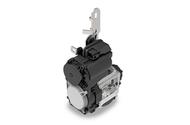New ZF-developed seatbelt meets tougher safety requirements; more sympathetically manages effect on body
However smart cars are getting at avoiding or reducing the seriousness of accidents, engineers haven’t stopped looking at new ways to improve in-car passive safety too.
ZF recently announced a new prototype seatbelt technology that is due to go into service first with a European car manufacturer in 2025.
Based on a multi-stage load limiter (MSLL), the system adapts the power of its response to the size and weight of the wearer, rather than taking a one-size-fits-all approach.
The idea is to manage the effect on a human body more sympathetically as a crash takes its course, from the initial impact through to the point when person meets airbag.
It is designed to meet the tougher requirements of the Vision 2030 plan that safety assessment organisation Euro NCAP published in late 2022.
This called for “occupant classification and the monitoring of vehicle occupancy during drivingâ€, which could be used to beef up safety functions such as airbag deployment and seatbelt load limiters that adapt to body size, weight and type.
That pretty well sums up what ZF’s MSLL is designed to do. Active restraint systems such as seatbelt pretensioners have been around for more than two decades. They intervene early on and, if the car’s sensors detect that an accident is unavoidable, tighten the belt on the body.
Existing systems have no way of taking into account the size and weight of who they’re protecting. They still work well, but Euro NCAP wants to see them do better.
Mercedes-Benz launched its Pre-Safe system back in 2002. The active control retractor at its core was produced by TRW, which was acquired by ZF in 2015 and formed the tier-one supplier’s new Active and Passive Safety division.
Some systems today have a two-stage controllable load limiter (TSLL), but MSLL will go a lot further, giving engineers various options if it’s hooked up to sensors both inside and outside the car.
Being multi-stage, it can vary the restraining forces during the stages of the crash and also vary force based on the size, weight and shape of the occupant. It can also take into account ‘out of position’ scenarios where occupants may be twisting around or somehow not sitting in a way that allows the seatbelt to be most effective.
Information gleaned by interior cameras detecting occupant movements will help drive the system. Sensors in the seatbelt can measure how far it has been pulled out and therefore get an idea of the circumference of the person’s body and thus their size and weight.
Links to external radar and cameras will allow the networked system of MSLL seatbelts to know which direction an impact is coming from. Armed with that knowledge, it can adapt to smaller people, including children in the back seat, for example, particularly in low-speed accidents at up to around 20mph.
It can also go easy on older people, who have a higher risk of injury, and heavier people, particularly at speeds of over 35mph.

